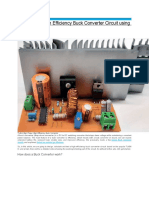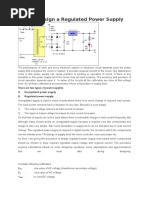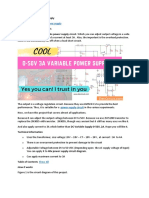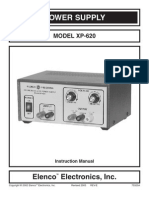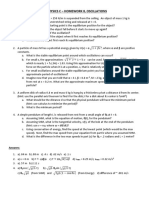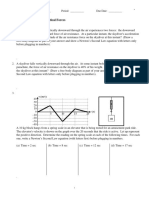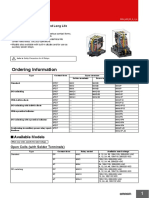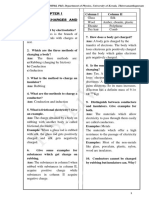Projects
Uploaded by
ameer hamzaProjects
Uploaded by
ameer hamzaClap switch:
Working Explanation
Here we are using Electric Condenser Mic for sensing the sound, transistor to trigger the
555 timer IC and 555 IC to turn ON the LED through a low voltage trigger.
Components
Condenser Mic
555 Timer IC
Transistor BC547
Resistors (220, 1k, 47k, 100k ohm)
Capacitor (10uF)
LED and Battery (5-9v)
http://circuitdigest.com/electroniccircuits/clap-switch-project
Simple metal detector:
Circuit Components
+9 supply voltage
555 IC
47K resistor
2.2F capacitor (2 pieces)
Speaker (8)
170Turns of 10cm diameter coil (any gauge would
work)
Link: http://circuitdigest.com/electroniccircuits/simple-metal-detector-circuit
Solar Battery Charger Circuit Diagram:
Circuit Components
Solar panel 17V
LM317 voltage regulator
DC battery
Diode 1n4007
Capacitor 0.1uF
Schottky diode 3A, 50V
Resistors 220, 680 ohms
Pot 2K
Connecting wires
Details:
Solar Battery Charger Circuit Design
Circuit must have adjustable voltage regulator , so Variable voltage regulator LM317 is
selected. Here LM317 can produce a voltage from 1.25 to 37 volts maximum and
maximum current of 1.5 Amps.
Adjustable Voltage regulator has typical voltage drop of 2 V-2.5V .So Solar panel is
selected such that it has more voltage than the load. Here I am selecting 17v/5w solar
panel.
Lead acid battery which is used here has specification of 12v/1.3Ah. In order to charge
this battery following are required.
Schottky diode is used to protect the LM317 and panel from reverse voltage generated
by the battery when it is not charging. Any 3 A diode can be used here.
For Charging 12V Battery
Output voltage
Set the output voltage to 14.5 volts(This voltage is specified on the battery as cycle use.)
Charging current
Charging current = Solar panel wattage/Solar Panel Voltage = 5 / 17 = 0.29A.
Here LM317 can provide current upto 1.5A .So it is recommended to use high wattage
panels if more current is required for your application.(But here my battery requires initial
current less than 0.39Amps. This initial current is also mentioned on the battery).
If the battery requires initial current more than 1.5A,it is not recommended to use LM317.
Time taken for charging
Time taken for charging = 1.3Ah/0.29A = 4.44hours.
Power dissipation
Here solar panel has 5Watts
Power going into battery = 14.5*0.29 =4 watts
Thus 1 watt of power going into regulator.
All the above mentioned parameters have to be taken into account before charging a
battery.
For 6V Application
Set the output voltage to 7.5-8 volts as specified on the battery.
calculate the charging current ,power dissipation as shown above.
Power Dissipation
In this project, power is limited because of the thermal resistance of LM317 voltage
regulator and the heat sink. To keep the temperature below 125 degree Celsius, the
power must be limited to 10W. LM317 voltage regulator internally has temperature
limiting circuit so that if it gets too hot, it shuts down automatically.
When battery is charging, heat sink becomes warm. When completing the charging at
maximum voltage, heat sink runs hot. This heat is because of excess power that not
needed in the process of charging a battery.
Current Limiting:
As the solar panel provides constant current, it acts as a current limiter. Therefore the
circuit does not need any current limiting.
Solar Charger Protection:
In this circuit, capacitor C1 protects from the static discharge. Diode D1 protects from
the reverse polarity. And voltage regulator IC provides voltage and current regulation.
Solar Charger Specifications:
Solar panel rating: 20W (12V) or 10W (6V)
Vout range: 5 to 14V
Maximum power dissipation: 10W (includes power dissipation of schottky diode)
Typical drop out value: 2 to 2.75V (depends on load current)
Max current: 1.5A (internally it limited to 2.2A)
Voltage regulation: +/- 100mV
How to Operate this Solar Battery Charger Circuit?
1.
Give the connections according to the circuit diagram.
2.
Place the solar panel in sunlight.
3.
Now set the output voltage by adjusting pot RV1
4.
Check the battery voltage using digital multi meter.
Solar Battery Charger Circuit Advantages:
Adjustable output voltage
Circuit is simple and inexpensive.
Circuit uses commonly available components.
Zero battery discharge when no sunlight on the solar panel.
Solar Battery Charger Circuit Applications:
This circuit is used to charge Lead-Acid or Ni-Cd batteries using solar energy. (You may
get an idea about How a Lead Acid Battery Charger Circuit Works by reading the
earlier posts.)
Limitations of this Circuit:
1.
In this project current is limited to 1.5A.
2.
The circuit requires high drop-out voltage
Link:
http://www.electronicshub.org/solar-battery-charger-circuit/
Circuit Diagram of Cell Phone Detector:
Circuit Components:
V1 = 12V
L1 = 10uH
R1 = 100Ohms
C1 = 100nF
R2 = 100K
R3 = 3K
Q1 = BC547
R4 = 200 Ohms
R5 = 100 Ohms
IC1= LM339
R6 = 10 Ohms
LED = Blue LED
Link: http://www.electronicshub.org/cellphone-detector-circuit/
Simple mobile jammer circuit:
Link:
http://www.electronicshub.org/wp-
content/uploads/2013/10/MobileJammer-Circuit-Diagram.jpg
Circuit Diagram of Metal Detector:
Metal Detector Circuit Explanation:
When the LC circuit that is L1 and C1 has got any resonating frequency from any metal
which is near to it, electric field will be created which will lead to induces current in the coil
and changes in the signal flow through the coil.
Variable resistor is used to change the proximity sensor value equal to the LC circuit, it is
better to check the value when there is coil not near to the metal. When the metal is
detected the LC circuit will have changed signal. The changed signal is given to the
proximity detector (TDA 0161), which will detect the change in the signal and react
accordingly. The output of the proximity sensor will be of 1mA when there is no metal
detected and it will be around 10mA when coil is near to the metal
When the output pin is high the resistor R3 will provide positive voltage to transistor Q1.
Q1 will be turned on and led will glow and buzzer will give the buzz. Resistor r2 is used to
limit the current flow.
Link:
http://www.electronicshub.org/metaldetector-circuit/
You might also like
- Speed Control of DC Motor Using Lm317 Voltage Regulator100% (5)Speed Control of DC Motor Using Lm317 Voltage Regulator18 pages
- 0-60V Dual Variable Power Supply Circuit Using LM317&LM337No ratings yet0-60V Dual Variable Power Supply Circuit Using LM317&LM3376 pages
- First Quadrant Single Phase Ac To DC Converter Semiconverter Separately Excited DC MotorNo ratings yetFirst Quadrant Single Phase Ac To DC Converter Semiconverter Separately Excited DC Motor9 pages
- Solar Battery Charging and Single Phase Supply System: 1) What Is A Solar Cell?No ratings yetSolar Battery Charging and Single Phase Supply System: 1) What Is A Solar Cell?14 pages
- High Power High Efficiency Buck Converter Circuit Using TL494100% (1)High Power High Efficiency Buck Converter Circuit Using TL49415 pages
- Bridge Wave Rectifier With Regulator Ic 9V & 5V:: Voltage Sensing CircuitNo ratings yetBridge Wave Rectifier With Regulator Ic 9V & 5V:: Voltage Sensing Circuit3 pages
- Let's Learn How Cell Phone Charger Circuit Work - ElecCircuit - Com2No ratings yetLet's Learn How Cell Phone Charger Circuit Work - ElecCircuit - Com226 pages
- How To Connect A Voltage Regulator in A CircuitNo ratings yetHow To Connect A Voltage Regulator in A Circuit3 pages
- Assembling AC DC Power Supply Power PointNo ratings yetAssembling AC DC Power Supply Power Point29 pages
- Department of Electronics and InstrumentationNo ratings yetDepartment of Electronics and Instrumentation15 pages
- K193 - Smart SLA Battery Charger: Heatsink Will Be Too Hot To TouchNo ratings yetK193 - Smart SLA Battery Charger: Heatsink Will Be Too Hot To Touch3 pages
- 13.8 V - 15 A From A PC Power Supply PDFNo ratings yet13.8 V - 15 A From A PC Power Supply PDF7 pages
- This Is 20 Watt Power Audio Amplifier Which Use IC LM1875 As Main ComponentNo ratings yetThis Is 20 Watt Power Audio Amplifier Which Use IC LM1875 As Main Component14 pages
- Cheap 220V AC Mobile Charger Circuit Diagram0% (1)Cheap 220V AC Mobile Charger Circuit Diagram3 pages
- Transistor Variable Power Supply 1A 0 30VNo ratings yetTransistor Variable Power Supply 1A 0 30V6 pages
- 12 Volt To 230 Volt Inverter Circuit Diagram Using IC 5550% (1)12 Volt To 230 Volt Inverter Circuit Diagram Using IC 55526 pages
- DC-Motor Driver Circuits: Using TransistorNo ratings yetDC-Motor Driver Circuits: Using Transistor14 pages
- Charging Section 5.1 What Is A Transformer?: Chapter Five Transformer andNo ratings yetCharging Section 5.1 What Is A Transformer?: Chapter Five Transformer and9 pages
- Reference Guide To Useful Electronic Circuits And Circuit Design Techniques - Part 1From EverandReference Guide To Useful Electronic Circuits And Circuit Design Techniques - Part 12.5/5 (3)
- Chapter 4-Anaylysis of Simple Structures, 2023No ratings yetChapter 4-Anaylysis of Simple Structures, 202322 pages
- Performance Analysis of H5 Topology of Transformerless InverterNo ratings yetPerformance Analysis of H5 Topology of Transformerless Inverter6 pages
- Six Ideas That Shaped Physics - All Units 3rd Edition Thomas A. Moore All Chapter Instant DownloadNo ratings yetSix Ideas That Shaped Physics - All Units 3rd Edition Thomas A. Moore All Chapter Instant Download49 pages
- Electrostatic Motors v5 With Covers (2023!05!21 06-00-55 UTC)No ratings yetElectrostatic Motors v5 With Covers (2023!05!21 06-00-55 UTC)162 pages
- Electronics Engineering Mastery Test 7 ECE Pre-Board PDFNo ratings yetElectronics Engineering Mastery Test 7 ECE Pre-Board PDF29 pages
- Mae 3241: Aerodynamics and Flight Mechanics: Introduction To Lifting Line TheoryNo ratings yetMae 3241: Aerodynamics and Flight Mechanics: Introduction To Lifting Line Theory28 pages
- Non - Rectangular Components: Prepared By: D.M.ONo ratings yetNon - Rectangular Components: Prepared By: D.M.O2 pages
- Cambridge Pre-U Certificate: Cambridge Assessment International EducationNo ratings yetCambridge Pre-U Certificate: Cambridge Assessment International Education8 pages
- Reactive Power Management in Renewable Rich Power Grids: A Review of Grid-Codes, Renewable Generators, Support Devices, Control Strategies and Optimization AlgorithmsNo ratings yetReactive Power Management in Renewable Rich Power Grids: A Review of Grid-Codes, Renewable Generators, Support Devices, Control Strategies and Optimization Algorithms32 pages
- Ap Physics C - Homework 8, Oscillations: AnswersNo ratings yetAp Physics C - Homework 8, Oscillations: Answers1 page
- Analysis of The Human Body As An Antenna For Wireless Implant CommunicationNo ratings yetAnalysis of The Human Body As An Antenna For Wireless Implant Communication12 pages
- Neutral Voltage Protection - 59GN - 95% Stator Earth Fault Protection - Electrical4uNo ratings yetNeutral Voltage Protection - 59GN - 95% Stator Earth Fault Protection - Electrical4u2 pages
- Higgs - The Invention and Discovery of The 'God Particle' (PDFDrive)No ratings yetHiggs - The Invention and Discovery of The 'God Particle' (PDFDrive)287 pages
- Electric Charges and Fields Practice Sheet Uthaan NEET 2024No ratings yetElectric Charges and Fields Practice Sheet Uthaan NEET 20247 pages
- Speed Control of DC Motor Using Lm317 Voltage RegulatorSpeed Control of DC Motor Using Lm317 Voltage Regulator
- 0-60V Dual Variable Power Supply Circuit Using LM317&LM3370-60V Dual Variable Power Supply Circuit Using LM317&LM337
- First Quadrant Single Phase Ac To DC Converter Semiconverter Separately Excited DC MotorFirst Quadrant Single Phase Ac To DC Converter Semiconverter Separately Excited DC Motor
- Solar Battery Charging and Single Phase Supply System: 1) What Is A Solar Cell?Solar Battery Charging and Single Phase Supply System: 1) What Is A Solar Cell?
- High Power High Efficiency Buck Converter Circuit Using TL494High Power High Efficiency Buck Converter Circuit Using TL494
- Bridge Wave Rectifier With Regulator Ic 9V & 5V:: Voltage Sensing CircuitBridge Wave Rectifier With Regulator Ic 9V & 5V:: Voltage Sensing Circuit
- Let's Learn How Cell Phone Charger Circuit Work - ElecCircuit - Com2Let's Learn How Cell Phone Charger Circuit Work - ElecCircuit - Com2
- K193 - Smart SLA Battery Charger: Heatsink Will Be Too Hot To TouchK193 - Smart SLA Battery Charger: Heatsink Will Be Too Hot To Touch
- This Is 20 Watt Power Audio Amplifier Which Use IC LM1875 As Main ComponentThis Is 20 Watt Power Audio Amplifier Which Use IC LM1875 As Main Component
- 12 Volt To 230 Volt Inverter Circuit Diagram Using IC 55512 Volt To 230 Volt Inverter Circuit Diagram Using IC 555
- Charging Section 5.1 What Is A Transformer?: Chapter Five Transformer andCharging Section 5.1 What Is A Transformer?: Chapter Five Transformer and
- Reference Guide To Useful Electronic Circuits And Circuit Design Techniques - Part 1From EverandReference Guide To Useful Electronic Circuits And Circuit Design Techniques - Part 1
- Performance Analysis of H5 Topology of Transformerless InverterPerformance Analysis of H5 Topology of Transformerless Inverter
- Six Ideas That Shaped Physics - All Units 3rd Edition Thomas A. Moore All Chapter Instant DownloadSix Ideas That Shaped Physics - All Units 3rd Edition Thomas A. Moore All Chapter Instant Download
- Electrostatic Motors v5 With Covers (2023!05!21 06-00-55 UTC)Electrostatic Motors v5 With Covers (2023!05!21 06-00-55 UTC)
- Electronics Engineering Mastery Test 7 ECE Pre-Board PDFElectronics Engineering Mastery Test 7 ECE Pre-Board PDF
- Mae 3241: Aerodynamics and Flight Mechanics: Introduction To Lifting Line TheoryMae 3241: Aerodynamics and Flight Mechanics: Introduction To Lifting Line Theory
- Cambridge Pre-U Certificate: Cambridge Assessment International EducationCambridge Pre-U Certificate: Cambridge Assessment International Education
- Reactive Power Management in Renewable Rich Power Grids: A Review of Grid-Codes, Renewable Generators, Support Devices, Control Strategies and Optimization AlgorithmsReactive Power Management in Renewable Rich Power Grids: A Review of Grid-Codes, Renewable Generators, Support Devices, Control Strategies and Optimization Algorithms
- Analysis of The Human Body As An Antenna For Wireless Implant CommunicationAnalysis of The Human Body As An Antenna For Wireless Implant Communication
- Neutral Voltage Protection - 59GN - 95% Stator Earth Fault Protection - Electrical4uNeutral Voltage Protection - 59GN - 95% Stator Earth Fault Protection - Electrical4u
- Higgs - The Invention and Discovery of The 'God Particle' (PDFDrive)Higgs - The Invention and Discovery of The 'God Particle' (PDFDrive)
- Electric Charges and Fields Practice Sheet Uthaan NEET 2024Electric Charges and Fields Practice Sheet Uthaan NEET 2024



















